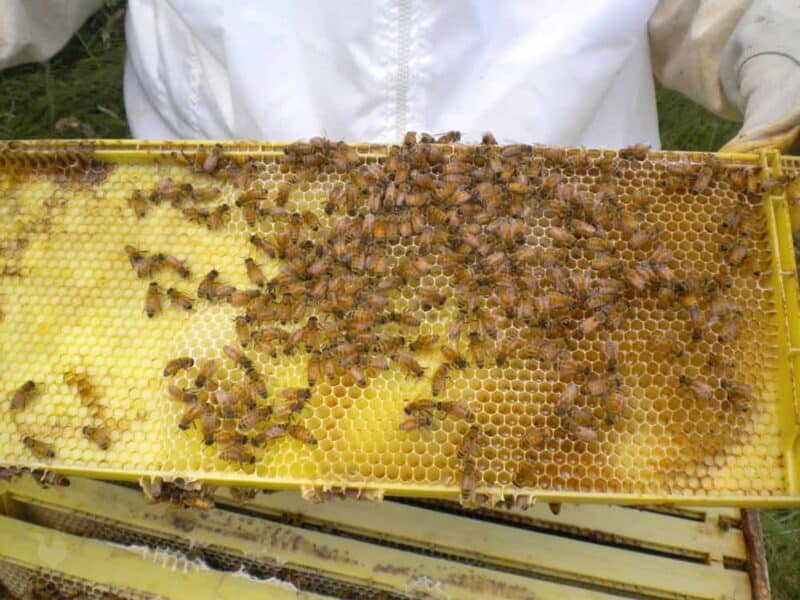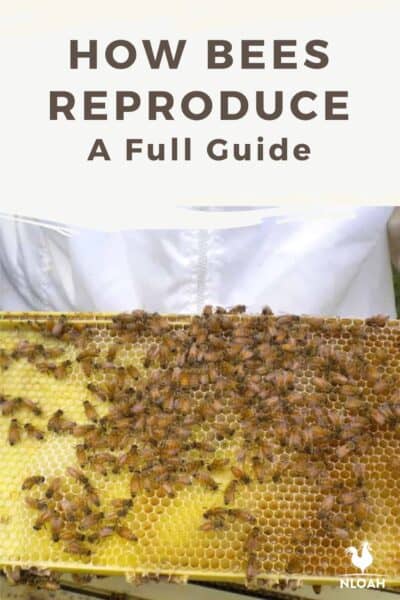If you’ve ever been up close with a beehive, assuming you weren’t running for your life, you’ve probably been as astounded as I was by the sheer number of bees inhabiting it.

Thousands and thousands – countless – bees all working and living in harmony for the good of the hive. It’s absolutely amazing!
But have you ever stopped to wonder where all those bees come from? And more, it seems like a hive can double in size almost overnight. There must be some serious reproductive magic going on, that’s for sure! And, in a way, there is…
The reproductive processes of insects are pretty fascinating in general, and I think none are more fascinating than bees.
If you’ve ever wondered how bees reproduce or if you’re thinking about becoming a beekeeper yourself, this is essential, need-to-know information. So, below I’ll be giving you a complete guide on the reproductive processes of honey bees.
Every Bee Comes from an Egg
It’s that old question: what came first, the bee or the egg? Well, considering this is a reproductive cycle, a cycle which repeats, we’ve got to start somewhere. I think the best place to do that is with an egg, the beginning of every, single bee.
Each and every bee, from the innumerable workers to the fertile drones and the ever-important queen comes from an egg…
Once an egg is laid in one of the many cells of the hive it will go through several stages of development before eventually emerging as an adult bee.
We’ll get more into those stages in just a little bit, but for now remember that that’s how things start. And of course, each one of those eggs must be laid- laid by the queen bee.
Only the Queen Bee Lays Eggs
The queen bee plays a singular role within the hive. She’s the largest and arguably the most important bee, and is solely responsible for laying the many, many following generations of bees that will replace the ones currently living in the hive.
Every worker, drone and even replacement queen will come from an egg that the queen lays. She lays these eggs in cells, hexagonal chambers made from wax, which the workers diligently and ceaselessly prepare for her.
Interestingly, the workers will make the cell a little bigger or a little smaller depending on what kind of bee is required, be it a female worker or a male drone. Drone cells are a bit bigger.
And most remarkably, the queen carefully inspects each and every cell for suitability prior to laying in it: it must be just the right size, symmetrical and polished on the inside or else it will be rejected.
Young Queens Go on a Mating Flight with Drones
Before any queen bee can lay an egg, she must be fertilized. Just like all other animals, a male and a female bee must “get together” in order to exchange genetic information. In this case, the male bees called drones mate with young, virgin female queens shortly after they are born.
This initial mating flight, sometimes called a nuptial flight, is the first thing that a queen must do before she settles down to her royal and critically important duties.
This is something of a grueling process: the very first newborn queen to emerge will kill her sister queens with her stinger so she will be the only survivor.
After this, once she is ready, she’ll soon leave the hive and head to a designated spot where queens and drones congregate for mating.
And, fun fact, even today no one is quite sure how drones and queens mutually figure out where to go in order to mate. Somehow, they just do!
A Queen Mates with Multiple Drones to Ensure Genetic Diversity
Note that when the queen embarks on her mating flight, she doesn’t just mate with a single, chosen suitor. Oh no; she will instead mate with multiple males to ensure adequate genetic diversity of the following generations.
Just like pretty much every other creature on earth, a lack of genetic diversity will quickly cause genetic instability, disease, and problems from inbreeding.
So, our young queen is definitely meeting and mingling and mating (in mid-flight!) with many different drones while she’s out on her maiden flight.
Interestingly, when a queen is fertilized by a drone she actually stores the drone’s sperm in a special compartment to be used at her discretion when laying eggs in the future.
Drones Die After Mating
During the mating process, when a drone succeeds at bedding the queen, his reproductive parts usually and unfortunately rip out, mortally wounding him. This is very similar to what happens when a worker honey bee uses her stinger on an enemy, as it also tears out.
The males don’t have stingers and cannot sting, but in any case, after mating, his purpose for the hive and his usefulness to his fellow bees is finished and he’ll die shortly thereafter. Assuming the male is not wounded from mating, he will not be allowed to return to the hive.
The Queen Returns to the Hive and Starts to Lay Eggs
After the mating flight, the queen is unharmed and will return to the hive to begin laying eggs. At this point, the queen has all of the sperm, and can produce all of the eggs needed for the rest of her life (or at least for the rest of her duties as the reigning queen over a hive).
And boy is she going to lay a lot of eggs! In the prime of her life, and under ideal conditions and high-demand, a queen can lay up to 3,000 eggs each and every day. And yes, that is day-in and day-out; no breaks and no holidays until winter!
And you thought you had a heavy workload at the office…
The Sex of a Bee is Determined by the Queen
As mentioned above, the queen will lay an egg in a cell that’s chosen according to the requirements of the hive, as determined by the workers depending on the challenges and status of the hive itself. It’s going to be a male drone, a female worker, or a new queen.
But what’s most remarkable, even though the size and type of the cell informs her what is needed, it is the queen herself that actually determines the sex of an egg!
She does this by deliberately choosing whether or not to fertilize every egg laid using the sperm she has stored from the drones.
If the queen fertilizes an egg, it will produce a female worker. If she does not fertilize the egg, it will produce a male drone.
Eggs Hatch into Larva
After the egg is laid, it will develop into a larva inside the cell in a few days. This is where a young bee looks very much like a tiny white worm or maggot, and not very much like a bee at all!
A larva will persist, safe inside the cell for around 9 days or so prior to emerging as a pupa, which looks like a small, white, partially-formed bee.
Larvae Develop into Pupae and then into Adult Bees
Once a larva has developed into a pupa it will then go through several stages as it matures.
These young bees are cared for by a fully developed and independent but young generation of worker bees known as nurse bees. These nurse bees are responsible for caring for the developing bees, and also the queen.
All adolescent bees get a little bit of royal jelly to supercharge their growth before being fed nectar and honey, but developing queens get a steady diet of royal jelly; that is why they are so much bigger, capable of laying eggs and finished growing so fast.
After about 3 weeks or a few days longer (or 16 days for a young queen), the new bee is fully developed as an adult, ready to emerge and start contributing to the hive according to its role and sex.
Eventually a Queen Must Leave to Start a New Colony or Be Replaced
This process continues, on and on, every day, until a queen is either too old, sick, or injured to continue laying eggs at an adequate pace.
At this time, by consensus of the workers, they will decide to raise up a new queen by feeding one of the larvae royal jelly continuously in order to turn a common worker pupa into an adolescent queen as detailed above.
Sometimes, a hive will be too successful and get too big, in which case a new queen will be raised up and the existing queen, who is still healthy and fertile, will take a contingent of workers from the colony population and leave to start a new but related colony somewhere else.
In both cases, the new, young queen will take over at the existing hive after returning from the mating flight as previously discussed.
But in the case of her replacing an older or underperforming queen, the old queen will be killed by the workers through supersedure, a process often known as bee-balling:
The workers surround the old queen and vibrate their wings to overheat her and literally cook her alive! Brutal, yes, but it’s for the good of the colony…
And The Cycle Repeats..
And with the installation of a new, young queen, the reproductive cycle I’ve outlined here will go on until such time as the colony collapses and the last queen is dead.
And that’s it! And now you know about the fascinating reproductive process of the common, humble honey bee. So, the next time you see a bustling hive of bees, you’ll now have intimate knowledge of the incredibly busy inner workings.

Tom has lived and worked on farms and homesteads from the Carolinas to Kentucky and beyond. He is passionate about helping people prepare for tough times by embracing lifestyles of self-sufficiency.
